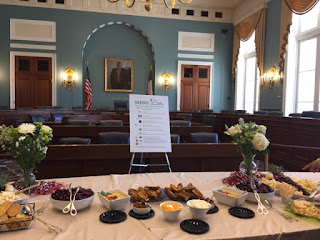Communications
In healthcare, a little prevention goes a long way. It can reduce costs, worries and disease. And in the case of rabies vaccination, the old axiom holds true for pets and for people.
 |
| A free clinic at the S’Klallum Tribal Center last month inoculated 62 dogs and 18 cats against rabies. |
That’s why WSDA veterinarian Dr. Minden Buswell pitched in to staff a free rabies vaccination clinic at the S’Klallum Tribal Center in Port Gamble last month. The program not only improves animal welfare, it also can protect people and save trips to the doctor – for children, in many cases.
When an unvaccinated pet bites someone, that person may be exposed to this incurable and fatal disease. In some circumstances, the bite may lead to a life-saving, but expensive and unpleasant series of shots for the victim. The same is true if the vaccination status of the offending animal is unknown.
But people can safely forego the stress and expense of getting rabies prevention shots after an animal bites, provided they know the animal has been vaccinated.
“By vaccinating a pet for rabies, a veterinarian protects the pet’s life, the human lives this pet enhances on a daily basis, and whole community in which the pet lives,” Buswell said. “One small shot can help prevent and relieve the medical and economic suffering of a community. This is why I became a veterinarian and why I am so honored to taken part in this clinic for the last three years.”
The tribal center’s annual vaccination clinic has reduced the number of people who require the preventative shots because it provides a system by which the community can quickly identify pets that have been immunized.
There’s an app for that
The information about which animals have been vaccinated is now available to the community through an app. After having their animal vaccinated, pet owners receive collars and tags with Quick Response (QR) codes, allowing anyone with a cell phone to take a picture and learn that animal is up-to-date on its rabies vaccinations. Reservation police also get copies of vaccination certification for records purposes.
The Washington State Department of Health hosts the clinic. Intern students organized the event and WSDA and USDA support it. Dr. Buswell is on hand to provide small animal veterinary equipment and perform the vaccinations.
 |
| Cats, or any mammal for that matter, can carry rabies. |
In total, 80 animals, 62 dogs and 18 cats, were vaccinated at this year’s clinic.
That can make a big impact for everyone involved, Buswell said.
“Rabies is nearly 100 percent fatal to all that contract the disease, human or animal,” she said. “As a veterinarian, our professional oath calls on us ’to use [our] scientific knowledge and skills for the benefit of society through the protection of animal health and welfare, the prevention and relief of animal suffering, the conservation of animal resources, the promotion of public health, and the advancement of medical knowledge.’
“The Port Gamble S’Klallam Tribe rabies vaccination clinic is an event that embodies ALL the principles of the veterinary oath,” Buswell said.
For more information about animal health, visit the WSDA Animal Health Program webpage or contact us at 360-902-1878.














